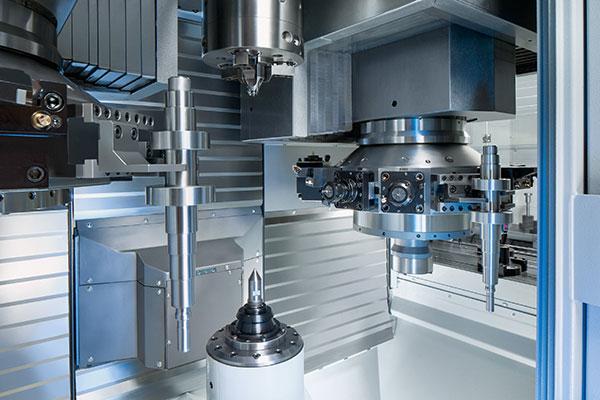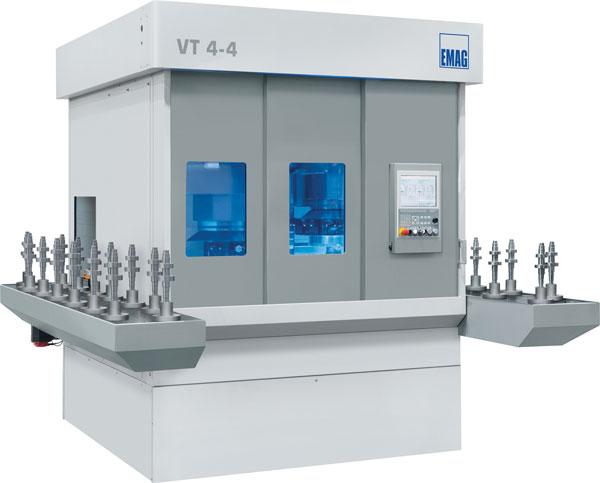- FMA
- The Fabricator
- FABTECH
- Canadian Metalworking
Technology Spotlight: Vertical Turning Machine
Automotive production demands efficiency, precision
- By Joe Thompson
- March 19, 2015
- Article
- Metalworking

Automotive manufacturers use 4-axis vertical machining for large batches of gear shafts. Photo courtesy EMAG.
According to a recent study by Roland-Berger, the automotive supplier industry will grow at a rate of approximately 6 percent in the next two years, and competition will intensify. To gain an advantage, manufacturers must take a close look at the profitability of their production sites.
Component production must become faster, deliver high precision, and show a greater degree of economic viability. To do so, EMAG has released the VT 4-4 vertical lathe.
“The automotive market here in Canada uses a lot of vertical technology, because it offers a smaller footprint than horizontals without sacrificing productivity,” explained Jeff Moore, Canadian regional sales manager for EMAG. “This system allows the machinist to turn between centers vertically, and this has a positive impact on cycle time.”
According to Moore, this machine helps reduce cycle time in two ways:
- Producing high horsepower with a direct-drive spindle
- Using a polymer granite base, which dampens vibration.
The machine base is made of MINERALIT ® polymer concrete. It carries all technology modules, including the workspindle, turrets, and the tailstock. Its rigid, vibration-resistant construction creates a vibration-resistant turning process, which ensures high-quality surfaces and highly accurate geometries, the company states.
The vertical alignment of the workpiece also helps produce a constant process integrity, because chip flow is unhindered and chips don’t accumulate in the machining area.
“Chip control is easier in a vertical setup because they are falling with gravity,” said Moore.
This enables machinists to push their tooling as hard as possible to also reduce cycle times.
For a number of reasons, the production of drive and gear shafts representsa very specific key task in the manufacture of automobiles. For one, many of the components are of a very detailed and highly complex geometry. For instance, high-precision gearings ensure highly effective torque transmission within the gearbox. Having high-precision shoulders and grooves allows for the safe connectivity of components.
The efficiency of the powertrain as a whole depends to a large degree on the functionality of the shafts. These highly complex components are produced in batches of millions, and, on completion of the turning work on the shaft, they should ideally display a geometry that is as close to its final contour as possible. Tolerance production planners look for the micrometer range of the shaft.

The machine is loaded and unloaded simultaneously with grippers located in the two turrets. Workpieces are transported on conveyor belts located on the left and right of the machine. Photo courtesy EMAG.
“These machines are very popular, especially when paired with a vertical chucking machine for the production of shafts,” said Moore. “Fast workpiece changeovers and short cycle times are made possible with the integrated automation system. Forgings are roughed on one machine, transferred over without the need for a robot, and finished on this second machine.”
This 4-axis vertical shaft turning machine can turn components with a maximum length of 41 inches and a maximum diameter of 8 in.
Simultaneous machining is carried out in four axes at a maximum speed of 4,500 RPM. The process employs two turrets with 12 tool stations each, equipped with turning tools or driven tools.
Automated workpiece grippers move the raw parts to the machining area and remove the finished components. One gripper inserts a new, raw part into the machine, while the other gripper removes the finished component from it.
In its standard model, the machine also is equipped with two recirculating conveyors that accommodate up to 28 raw parts and 28 finished components, respectively.
“These machines can handle large volumes of a single part and still also work with a family of parts,” said Moore.
The machine also doesn’t need to be opened to measure a part.
“In our machines we also have integrated probes, so we are able to measure the part as well,” said Moore. “Also, to change an insert, all the operator has to do is swap it out and use the tool life reset function. This function probes the part and automatically calculates the tool offset.”
When the part is finished, the machine probes the part a final time.
“We try to minimize door-open time, because when the door is closed and you are turning a part, you know you are being productive,” said Moore. “Uptime is a key indicator for manufacturers, so we try to keep the machine busy for as much time as possible.”

The VT 4-4 is a 4-axis shaft turning machine for workpieces up to 41 in. long with a maximum diameter of 8 in. Photo courtesy EMAG.
The company also designed the machine with ease of operation in mind. Because the human factor is important to maintaining high productivity, it’s important to make the machine as easy to use as possible for the operator. To achieve this, all relevant components, including electronics, hydraulics, and the cooling system, are accessed by the user interface.
“One of the biggest concerns you hear throughout the automotive market is making sure that operators will be comfortable with the machine,” said Moore. “All of our machines come with FANUC controllers, so they always will be familiar to operators. We also only present information on the screen that operators need for the part they are running, which eliminates the unnecessary data that they don’t need.”
There also is no need for additional automation, because it already is integrated into the machine.
subscribe now


Keep up to date with the latest news, events, and technology for all things metal from our pair of monthly magazines written specifically for Canadian manufacturers!
Start Your Free Subscription- Trending Articles
- Industry Events
MME Winnipeg
- April 30, 2024
- Winnipeg, ON Canada
CTMA Economic Uncertainty: Helping You Navigate Windsor Seminar
- April 30, 2024
- Windsor, ON Canada
CTMA Economic Uncertainty: Helping You Navigate Kitchener Seminar
- May 2, 2024
- Kitchener, ON Canada
Automate 2024
- May 6 - 9, 2024
- Chicago, IL
ANCA Open House
- May 7 - 8, 2024
- Wixom, MI














